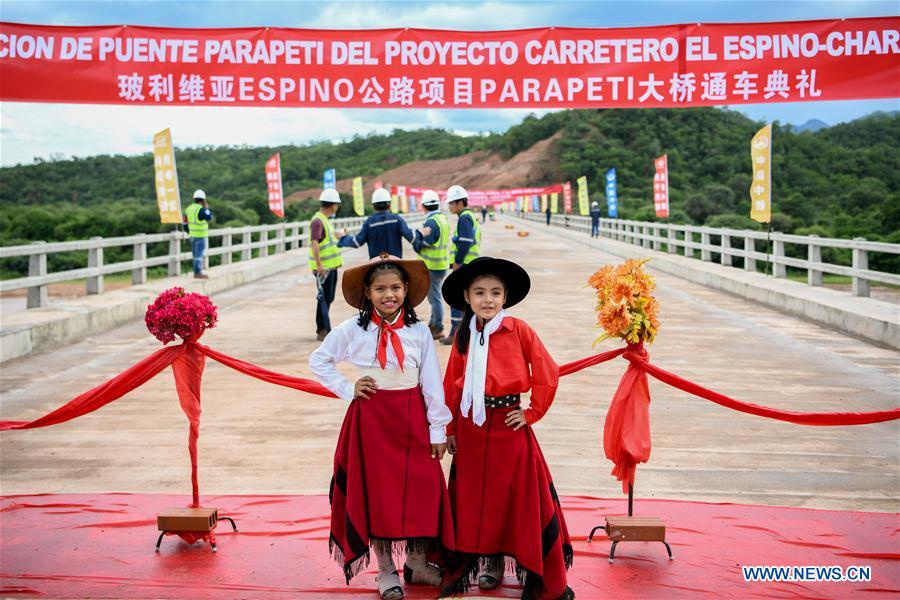
Local kids pose for a group photo at the opening ceremony of the Parapeti Bridge on the under-construction El Espino-Charagua-Boyuibe Highway in Santa Cruz, Bolivia, Feb. 7, 2020. Nearly 50 percent complete, according to the Bolivian Highway Administration (ABC), the 160-km El Espino-Charagua-Boyuibe Highway will directly link the country's eastern departments of Santa Cruz, Chuquisaca and Tarija with each other and with neighboring Paraguay and Argentina. (Xinhua/Xin Yuewei)
by Xinhua writers Yan Liang, Shooka Shemirani
MEXICO CITY, Feb. 6 (Xinhua) -- An ambitious China-backed roadway project in Bolivia will make it faster and easier to transport local goods regionally and internationally, boosting production and benefiting Bolivians, South Americans and eventually Chinese consumers across the Pacific Ocean.
Nearly 50 percent complete, according to the Bolivian Highway Administration (ABC), the 160-km El Espino-Charagua-Boyuibe Highway will directly link the country's eastern departments of Santa Cruz, Chuquisaca and Tarija with each other and with neighboring Paraguay and Argentina.
As a flagship project within the framework of the China-proposed Belt and Road Initiative (BRI), the El Espino highway program in Bolivia is a prominent symbol of how win-win cooperation between China and Latin America helps all sides make progress and realize common development in an effort to build a community with a shared future for mankind.
It is also a concrete proof of the viability and potential of the BRI to stimulate the world economy through increased trade, enhanced infrastructure and expanded integration.
The El Espino highway is a high-impact infrastructure project that has brought benefits to communities along the route by hiring local work force, the ABC's regional manager for Santa Cruz, Enrique Concepcion, has said.
In the lead-up to this week's opening ceremony of the 306-meter-long Parapeti Bridge, one of the highway's four longest bridges, Concepcion said multiple regions and industries would stand to benefit from the project.
"Once the roadway is finished, it will reduce travel time from Santa Cruz to the towns of Charagua and Boyuibe, connecting the departments of Chuquisaca and Tarija, and internationally with Paraguay and Argentina, in addition to spurring regional agriculture and cattle-ranching, as well as tourism," Concepcion said.
As an international public good based on mutual respect and win-win cooperation, the BRI is a welcome formula for Latin America.
Today, China has become the second-largest trade partner of Latin America, and Chinese enterprises have created over 1.8 million jobs in the region. Products from Latin America and the Caribbean region, such as Mexican avocado, Chilean cherry, Ecuadorian shrimp and Bolivian organic quinoa, have been enjoying huge popularity in China, which is in a new era of opening-up and forging closer ties with other countries.
From highways to ports, from high-tech products to financial services, cooperation between Latin America and China in various fields has brought benefits to the two peoples. Just as Brazilian economist Elias Jabbour has said, as one of the engines of the global economy, "China has the economic and financial conditions to bring prosperity to Latin America."
Though geographically far apart from each other, China's efforts to localize the BRI in Latin America and the Caribbean region have been widely recognized by local people and the El Espino highway program is just a telling example of their cooperation.
As Guillermo Holzmann, political analyst and professor with the University of Chile and the Adolfo Ibanez University, has pointed out, China behaves pragmatically in Latin America ... without intervening in the internal politics of Latin American countries and without exerting pressure.
The El Espino highway is a road for development, but far beyond a road. The win-win cooperation between China and Latin America within the framework of jointly building the BRI will surely serve as a model for South-South cooperation, injecting new impetus to building a community with a shared future for mankind.



